
Wine Culture and Information since 2002 - Volume 22
 Wine Culture and Information since 2002 - Volume 22 |
|
Issue 123, November 2013 |
Contents |
|
|
The Ups and Downs of Wine |
|
Wine, magnificent protagonist of our culture, history and tradition, is also an element strongly connected to fashions, trends and opportunities of the moment. Last but not the least, it is also connected to economic and marketing conditions. In these times, clearly not prosperous and very complicated, times that everyone - more or less - define as “crisis”, also wine, undoubtedly, is affected by this condition. A beverage getting a strong identifying meaning for our Country - Italy - it is however undeniable wine does not represent today a primary need for people. From fundamental element of living in past times - considered as a food and beverage of sustenance - nowadays wine plays a different role, a cultural radical change which mainly transformed it into a beverage for the élite. Nowadays, wine is in fact mainly associated to cultural and intellectual factors, still found in the table as a loyal companion of good cooking, however playing a different role. Wine consumption, from a raw and direct point of view, is measured, just like any other good, by cold numbers. Numbers telling the specific condition at a given moment and providing the measure with which the glasses of wine lovers and occasional drinkers are being filled. There are also numbers measuring the difference between the quantity of wine produced in a specific period and what it is actually consumed or representing the real needs of the market. Of the news we receive every year during harvesting times, two in particular give me a certain cheerfulness, in particular for the disputable importance of one of them. I am talking about the breaking news repeating every year and that recently, lucky us, is happening less and less, telling - every year and with the same emphasis - every new harvesting is going to be the one of the century. The other news, which I consider truly “amazing”, is the annual competition between Italy and France in order to win the prize of first wine producer of the world. A truly amazing match, like those - for the ones who are interested in football - played by Italy and France in occasion of the world championship and, in that occasion, the Country finally gets united, ready to affirm its national pride, like everyone would do for important occasions. This year, 2013, Italy reaches again the top of the wine Olympus by showing the world its prestigious prize, by defeating the cousins living on the other side of the Alps for the quantity of wine produced from its vineyards. Italy is again the first wine producer of the world, by leaving to France only the second place. Production figures suggest Italy will make 44 millions of hectoliters of wine, maybe 45, whereas the French will make 43.5 only. We are the best! We have won! We are the world champions! Then, in the next months, usually in springtime, we will see other news - also in this case recurring every year and not something to be happy for - telling the difficulties of Italian wineries in selling their wine. Here, frankly speaking, there is nothing to laugh about, no time for irony, as this is a serious and troublesome problem. Sales of wine, this is undeniable, are not good as it used to be. To realize this, you can watch the tables of a restaurant and count in how many of them you can see a bottle of wine. The number will be, in most of the cases, pretty modest. Some could raise an objection, the fault is also of restaurateurs and of their scarcely agreeable logics of profits, convinced wine is a product to speculate on. For the sake of truth, not all restaurants and restaurateurs are the same: some apply reasonable margin of profits, others - who I consider not truly intelligent - apply exorbitant margins and absolutely unjustified, and end up complaining their customers do not buy wine. The same happens, although differently, also in supermarkets, where we can usually see countless bottles on shelves, whole areas completely dedicated to wine. Here things are a little better, however, if we take a look at customers' carts, in few of them you can spot wine bottles and, in those where you spot one, in most of the cases, it is a bottle having a modest value, economically speaking, of course. Producers, more or less, complain about the same difficulty since many years: cellars are full, selling wine is not simple as it used to be. And the space in a cellar, when it is occupied, represents a cost. Wine consumption is not having its best time and people - denying this would have no use - limit the money they can spend and change their priorities according to their primary needs: wine is usually left at the bottom of the list. Wineries, as there is no alternative to this, try to find a better condition abroad, in those markets where everyone is trying to be: the match is fiercely played with the strategy of the lowest price possible. The annual wine competition between Italy and France, sees the appearance of a new competitor which, maybe, will be considered by many extraneous to this matters. Coldiretti, the Italian association of farmers which spread the news, tells us the third place is occupied by Spain followed by United States of America and, then, China. It is now many years that in this country wine is becoming more and more popular, both in production and - in particular - in terms of consumption. It is commonly known, some European wineries are considering China as a possible wine land, most of the time with the collaboration of Chinese firms, investing their capitals in vineyards and building highly technological wineries. Wine is getting more and more popular among Chinese entrepreneurs and, this is something to be certain of, they will soon be capable of making high quality wines, capable of competing with the ones of the Old World. Quality at a competitive price: something already happened in Australia, Chile, Argentina and in the other emerging wine countries of the world. We Italians can also be the first wine producers in the world, but soon our huge production of wine will be forced to compete with the bottles coming from these producers. The ups and downs of wine. We however are the best in the world: honor is saved. Antonello Biancalana
|
||||
The Time of WineWine sensorial tasting gives different interpretations according to time. A transformation in continuous evolution always giving new emotions |
|
Wine is a living beverage and in continuous evolution. Like persons, wine born, grows up and “dies” according to time and conditions of life. In this specific case, for life conditions are intended all those productive and keeping processes, from vineyard to glass. These factors will in fact determine the possibilities of development as well as the expectations of evolution according to time. The transformation wine undergoes during all of its evolution are frequently radical ones, also eliminating its young character when tasted after some years. This process, of course, is not infinite: wine, unavoidably, will reach its top of evolution and it will then proceed to its inexorable decay. Before this condition happens, wine is however in continuous evolution and offering different sensorial qualities. Time in which is realized the life of a wine is pretty variable. There are in fact wines capable of properly evolving for more than fifty years, whereas others can barely reach three years. Wines capable of standing to time - it should be clearly said - must be produced with this specific goal in mind, a process having no compromises and beginning in the vineyard. In every case, each variety has its own possibilities of evolution in time: also in case we are using the same productive criteria, every grape will hardly evolve beyond its own limits. For example, it is quite unlikely a wine made from Grignolino grape can significantly evolve for fifty years, something which can happen for a wine produced with Cabernet Sauvignon. In general terms, red wines have a better longevity than white wines, however it should be noticed there are some white wines capable of properly evolving for ten years, in rare case, even more. Among the wines having the best longevity, there also are sweet and fortified wines. To determine the longevity of a wine, first of all, we have the specific characteristics of grapes and, in particular, the presence and quantity of specific substances. These substances are therefore reinforced or attenuated during the phases of vinification, therefore the longevity of a wine is always the result of grape qualities and the procedures used in wine making. Like already said, Cabernet Sauvignon is a grape potentially capable of making wines of remarkable longevity. This characteristic can however be lost by using improper and ordinary viticultural and wine making procedures.
Given the right viticultural, enological and keeping conditions, time frequently works miracles in wine, by creating organoleptic profiles of extraordinary and rich complexity. On this regard, it should be defined the concept of time associated to wine. The concept of age connected to wine cannot be in fact measured in absolute terms like we do, for example, for persons. Every wine, every grape, every area - as to mention the main factors - are measurable in absolutely specific terms, by defining the specific ages and seasons according to each condition. We cannot in fact say - for example - every wine after three years must be considered still young, as this evaluation is strictly associated to quality and characteristics of each of them. A red wine, for example, can be considered still young after three years, but the same cannot be usually said for most of white wines. We can certainly talk about youth, maturity and decay for each wine, while considering the time in which can happen these conditions is always definable according to each case. Wines, also in case are produced with the same grapes and wine making techniques, can have different evolutions in the course of time, therefore their lifespan can be different. The discriminating factor, in this case, is represented by territory, the exposition of vineyards, micro-climate and composition of soil, as to mention the main factors. Territory, among the most important and determinant factors of quality and wine expression, affirms - also in this case - its fundamental importance. This means that, in a specific appellation, each single part of the territory, each cru, has, not only its own and specific organoleptic characteristics, but it can frequently make wines with different longevity. Factors determining the lifespan of a wine, besides the indispensable viticultural and keeping conditions, are many. The elements making a wine, besides defining its sensorial profile, determine in a good part its possibilities of evolution in time. The quantity of acidic substances, sugar, alcohol, carbon dioxide and polyphenols, determine in a good part the lifespan of a wine in a bottle. The keeping properties of these elements in fact allow the wine to stay alive, while allowing - at the same time - its evolution. The keeping properties of these substances are not infinite, as, with time, they undergo chemical modifications caused, for example, by the interaction with oxygen and light. The modifications these substances receive in the course of time affect - as a matter of fact - the sensorial evolution of every wine. This evolution can be easily understood in red wines, in which polyphenols are found in significant quantity. Let's consider, for example, the same red wine and produced in two different vintages, possibly with a difference of five years. The younger wine will taste more aggressive and astringent than the more mature one, in which astringency will be less aggressive and with a more pronounced roundness. The mitigation of astringency is the result of the molecular transformation of polyphenols occurring with time. During youth, the molecules of polyphenols have a smaller size and therefore they can better do their astringent action. With time, they tend to polymerize, therefore increasing their size, with the result of attenuating the characteristic astringency, while producing a rounder and smoother tactile sensation. The effect of time, as well as the good condition of keeping, can be determined, with a good approximation, by watching the appearance of wine. The change of color and transparency give in fact a measure of the age of wine, both in function of the specific style and in terms of keeping. With time, the color of wine, of any wine, tends to change its hue, by following a specific cycle according to style. In white wines, color tends to get darker and darker hues, up to getting a dark amber color which can also tend to brown. In red wines the change occurs differently, that is it gets a progressively lighter color as time goes by. In young red wines, in fact, colors are pretty dark and strongly characterized by blue and purple nuances, whereas with time, the red hue tends to get lighter up to getting an orange hue. Also transparency of wines, in particular red ones, changes with time. The example used above about polyphenols, is mainly responsible of this change. Polymerization of molecules, besides determining an increasing in size, also determines an increasing in weight, with the result they precipitate to the bottom while making the wine more transparent. This phenomenon can be easily observed by controlling the presence of the sediment in the bottom of the bottle. The formation of sediment takes place also in case of young wines which did not undergo any filtering process. In both cases it is not a fault but a simple condition of the wine - most of the times, a precise wine making choice - which does not alter the quality of wine. Finally, as for the changes of wine appearance taking place in the course of time, a fundamental role is played both by light and oxygen. The action of oxygen, as well as time, is one of the main factors responsible of the transformation - better to say, evolution - of wine aromas. Oxygen works its transformation on wine's aromatic qualities since the very first moments of its production, that is when the grape is being crushed in order to get the must, because of the effect of oxidation. Oxygen will in fact be part, in a more or less effective way, of the whole life of a wine. The quality of the changes made by oxygen in wine is mainly determined by its quantity and, like to say, the “violence” of its impact. In case the action of oxygen is done in a long time and slowly, a condition taking place only with very low quantity of oxygen, the effects on wine are generally considered as positive. The excess of oxygen is generally considered as a negative factor, except for those wines in which oxidation is a main and wanted quality, such as Marsala or Jerez. The positive effect of oxygen in wine is mainly done during the aging in wood containers, such as the cask and barrique. Oxygen, by passing through the pores of the wood, gets in contact with wine therefore determining its oxidation. The quantity of oxygen passing through the pores is however very low, therefore its impact will be limited and for a pretty long time. The action of oxygen also continues inside the bottle sealed with a cork. For the same reason happening inside a cask, oxygen passes through the pores of cork in very low quantity and reaches the wine, therefore allowing its evolution and aging. The effect of oxygen on aromas is mainly evident in those recalling fruits. With time and with oxygen, these aromas lose their typical freshness in order to get a more mature character, frequently recalling dried fruits or jam. Time also favors the development of wine aromas generally defined as tertiary enriching it with pretty complex sensations. A complexity which can be perceived to the nose and, therefore, to the taste of wine as well. In white and sparkling wines, time smooths the cutting acidity and gives a rounder wine, a roundness we also find in mature red wines, in which it is the astringency to attenuate its presence in the glass. Finally, as for the aging and time, it should be noticed this condition is usually positive for some wines, red and sweet wines in particular, in which youth represents an aggressive and non truly balanced period. In these wines will in fact be time and, like to say, the wisdom of waiting to give a fully developed and harmonic character. It must be said, these are wines of higher quality and produced with the specific goal to amaze over time.
|
||||||||||||
Wines of the Month |
|
|
|
Score legend Prices are to be considered as indicative. Prices may vary according to the country or the shop where wines are bought |
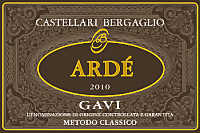
|
|
Gavi Spumante Metodo Classico Ardé 2010 |
|
| Castellari Bergaglio (Piedmont, Italy) | |
| Grapes: Cortese | |
| Price: € 20.00 | Score: |
| Gavi Spumante Metodo Classico Ardé shows a brilliant straw yellow color and nuances of straw yellow, very transparent, fine and persistent perlage. The nose denotes intense, clean, pleasing and refined aromas which start with hints of plum, bread crust and citrus fruits followed by aromas of apple, pear, yeast, hawthorn, broom, hazelnut and mineral. The mouth has good correspondence to the nose, an effervescent and crisp attack, however balanced by alcohol, good body, intense flavors, agreeable. The finish is persistent with flavors of apple, citrus fruits and hazelnut. Gavi Spumante Metodo Classico Ardé referments on its lees for 18 months. | |
| Food Match: Broiled fish, Stuffed pasta with fish, Stewed fish, Roasted white meat | |
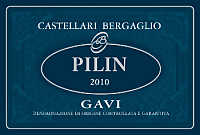
|
|
Gavi Pilin 2010 |
|
| Castellari Bergaglio (Piedmont, Italy) | |
| Grapes: Cortese | |
| Price: € 22.00 | Score: |
| Gavi Pilin shows a pale straw yellow color and nuances of straw yellow, very transparent. The nose reveals intense, clean, pleasing and refined aromas which start with hints of quince, ripe peach and pear followed by aromas of citrus fruits, ripe banana, hawthorn, broom, plum, vanilla and mineral. The mouth has good correspondence to the nose, a crisp attack and however balanced by alcohol, good body, intense flavors, pleasing roundness. The finish is persistent with flavors of quince, ripe peach and ripe banana. Gavi Pilin is produced with slightly dried grapes, ages for 12 months in barrique followed by 2 years of aging in bottle. | |
| Food Match: Roasted fish, Fish and mushroom soups, Stuffed pasta, Roasted white meat | |

|
|
Valdobbiadene Prosecco Superiore di Cartizze Dry 2012 |
|
| Bisol (Veneto, Italy) | |
| Grapes: Glera | |
| Price: € 19.30 | Score: |
| Valdobbiadene Prosecco Superiore di Cartizze Dry shows a brilliant greenish yeloow color and nuances of greenish yellow, very transparent, fine and persistent perlage. The nose reveals intense, clean, pleasing and refined aromas which start with hints of pear, wistaria and pineapple followed by aromas of apple, peach, tangerine, broom, chamomile and hawthorn. The mouth has good correspondence to the nose, an effervescent and crisp attack, however balanced by alcohol, good body, intense flavors, pleasing sweetness. The finish is persistent with flavors of pear, apple and pineapple. Valdobbiadene Prosecco Superiore di Cartizze Dry ferments in closed tanks. | |
| Food Match: Cream and fruit desserts | |
|
|
|
Valdobbiadene Prosecco Superiore di Cartizze Non Dosato Private 2011 |
|
| Bisol (Veneto, Italy) | |
| Grapes: Glera | |
| Price: € 33.90 | Score: |
| Valdobbiadene Prosecco Superiore di Cartizze Non Dosato Private shows a brilliant greenish yellow color and nuances of greenish yellow, very transparent, fine and persistent perlage. The nose denotes intense, clean, pleasing and refined aromas which start with hints of apple, plum and wistaria followed by aromas of bread crust, hawthorn, pineapple, broom, pear, tangerine and mineral. The mouth has good correspondence to the nose, an effervescent and crisp attack, however balanced by alcohol, good body, intense flavors, agreeable. The finish is persistent with flavors of apple, plum and pineapple. Valdobbiadene Prosecco Superiore di Cartizze Non Dosato Private referments in bottle for 11 months. | |
| Food Match: Fried fish, Pasta with fish, Broiled fish, Sauteed white meat | |
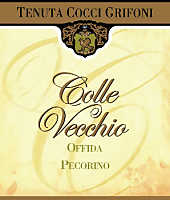
|
|
Offida Pecorino Colle Vecchio 2012 |
|
| Tenuta Cocci Grifoni (Marches, Italy) | |
| Grapes: Pecorino | |
| Price: € 10.00 | Score: |
| Offida Pecorino Colle Vecchio shows an intense greenish yellow color and nuances of greenish yellow, very transparent. The nose denotes intense, clean, pleasing and refined aromas which start with hints of pear, apple and broom followed by aromas of peach, plum, pineapple, medlar, hawthorn, chamomile and mineral. The mouth has good correspondence to the nose, a crisp attack and however balanced by alcohol, good body, intense flavors, agreeable. The finish is persistent with flavors of pear, apple and peach. Offida Pecorino Colle Vecchio ages for 4 months in steel tanks followed by 6 months of aging in bottle. | |
| Food Match: Pasta with fish, Mushroom soups, Sauteed white meat, Sauteed fish | |
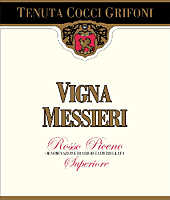
|
|
Rosso Piceno Superiore Vigna Messieri 2007 |
|
| Tenuta Cocci Grifoni (Marches, Italy) | |
| Grapes: Montepulciano (70%), Sangiovese (30%) | |
| Price: € 12.50 | Score: |
| Rosso Piceno Superiore Vigna Messieri shows a deep ruby red color and nuances of ruby red, little transparency. The nose denotes intense, clean, pleasing and refined aromas which start with hints of black cherry, blueberry and plum followed by aromas of violet, raspberry, vanilla, tobacco, cocoa, mace and menthol. The mouth has good correspondence to the nose, a properly tannic attack and however balanced by alcohol, good body, intense flavors, pleasing roundness. The finish is persistent with flavors of plum, blueberry and black cherry. Rosso Piceno Superiore Vigna Messieri ages in cask for 24 months followed by at least 6 months of aging in bottle. | |
| Food Match: Broiled meat and barbecue, Roasted meat, Stewed and braised meat, Hard cheese | |

|
|
Franciacorta Rosé Cellarius 2008 |
|
| Guido Berlucchi (Lombardy, Italy) | |
| Grapes: Pinot Noir (50%), Chardonnay (50%) | |
| Price: € 22.00 | Score: |
| Franciacorta Rosé Cellarius shows a brilliant onion skin pink and nuances of cherry pink, transparent, fine and persistent perlage. The nose reveals intense, clean, pleasing and refined aromas which start with hints of cherry, apple and plum followed by aromas of bread crust, raspberry, banana, tangerine, yeast, pear and hints of vanilla. The mouth has good correspondence to the nose, an effervescent and crisp attack, however balanced by alcohol, good body, intense flavors, agreeable. The finish is persistent with flavors of cherry, plum and tangerine. A part of the base wine ferments in barrique. Franciacorta Rosé Cellarius referments in bottle on its lees for at least 30 months. | |
| Food Match: Cold cuts, Pasta with meat, Roasted fish, Roasted white meat, Broiled crustaceans | |
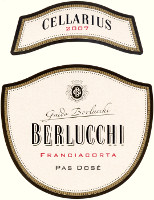
|
|
Franciacorta Pas Dosé Cellarius 2007 |
|
| Guido Berlucchi (Lombardy, Italy) | |
| Grapes: Chardonnay (80%), Pinot Noir (20%) | |
| Price: € 24.00 | Score: |
| Franciacorta Pas Dosé Cellarius shows a pale straw yellow color and nuances of straw yellow, very transparent, fine and persistent perlage. The nose denotes intense, clean, pleasing and refined aromas which start with hints of apple, banana and bread crust followed by aromas of plum, hawthorn, hazelnut, pear, grapefruit, butter and hints of vanilla. The mouth has good correspondence to the nose, an effervescent and crisp attack, however balanced by alcohol, good body, intense flavors, agreeable. The finish is persistent with flavors of apple, banana and grapefruit. A part of the base wine ferments in barrique. Franciacorta Pas Dosé Cellarius referments in bottle on its lees for about 42 months. | |
| Food Match: Fried fish, Stewed fish, Roasted white meat, Broiled fish and crustaceans | |
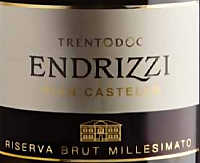
|
|
Trento Brut Riserva Pian Castello 2008 |
|
| Endrizzi (Trentino, Italy) | |
| Grapes: Chardonnay (60%), Pinot Noir (40%) | |
| Price: € 14.90 | Score: |
| Trento Brut Riserva Pian Castello shows a pale straw yellow color and nuances of straw yellow, very transparent, fine and persistent perlage. The nose denotes intense, clean, pleasing and refined aromas which start with hints of apple, banana e bread crust followed by aromas of citrus fruits, pear, yeast, hawthorn, plum, hazelnut and honey. The mouth has good correspondence to the nose, an effervescent and crisp attack, however balanced by alcohol, good body, intense flavors, pleasing roundness. The finish is persistent with flavors of apple, banana and plum. Part of the base wine ferments in barrique. Trento Brut Riserva Pian Castello referments in bottle on its lees for about 5 years. | |
| Food Match: Pasta with fish, Broiled crustaceans, Sauteed white meat | |
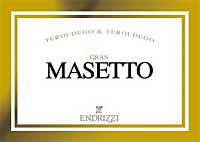
|
|
Gran Masetto 2009 |
|
| Endrizzi (Trentino, Italy) | |
| Grapes: Teroldego | |
| Price: € 37.00 | Score: |
| Gran Masetto shows a deep ruby red color and nuances of ruby red, little transparency. The nose reveals intense, clean, pleasing, refined and elegant aromas which start with hints of black cherry, blackberry and plum followed by aromas of violet, blueberry, vanilla, pink pepper, tobacco, chocolate, cinnamon, mace and menthol. The mouth has good correspondence to the nose, a tannic attack and however balanced by alcohol, full body, intense flavors, pleasing roundness. The finish is very persistent with long flavors of black cherry, blackberry and plum. Gran Masetto ages for 20 months in barrique followed by 6 months of aging in bottle. | |
| Food Match: Game, Roasted meat, Braised meat, Hard cheese | |
News |
|
In this section are published news and information about events concerning the world of wine and food. Whoever is interested in publishing this kind of information can send us a mail to our address.
|
Wine Parade |
|
|
| The best 15 wines according to DiWineTaste's readers. To express your best three wines send us an E-mail or fill in the form available at our WEB site. |
| Rank | Wine, Producer | |
|---|---|---|
| 1 |
| Camartina 2008, Querciabella |
| 2 |
| San Leonardo 2006, Tenuta San Leonardo |
| 3 |
| Brunello di Montalcino 2007, Donatella Cinelli Colombini |
| 4 |
| Trento Brut Riserva Methius 2006, Dorigati |
| 5 |
| Verdicchio dei Castelli di Jesi Classico Superiore Podium 2010, Garofoli |
| 6 |
| Avvoltore 2009, Moris Farms |
| 7 |
| Amarone della Valpolicella Classico Capitel Monte Olmi 2007, Tedeschi |
| 8 |
| Trento Talento Brut Riserva 2007, Letrari |
| 9 |
| Villa Gresti 2006, Tenuta San Leonardo |
| 10 |
| Confini 2007, Lis Neris |
| 11 |
| Franciacorta Pas Dosé Récemment Dégorgé 2006, Cavalleri |
| 12 |
| Langhe Riesling Herzu 2011, Ettore Germano |
| 13 |
| Offida Rosso Il Grifone 2006, Tenuta Cocci Grifoni |
| 14 |
| Brunello di Montalcino Vigna Loreto 2007, Mastrojanni |
| 15 |
| Sagrantino di Montefalco Collepiano 2007, Arnaldo Caprai |
| |||||||
Privacy Policy | |||||||


| Copyright © 2002-2024 Antonello Biancalana, DiWineTaste - All rights reserved |
| All rights reserved under international copyright conventions. No part of this publication and of this WEB site may be
reproduced or utilized in any form or by any means, electronic or mechanical, without permission in writing from DiWineTaste. |